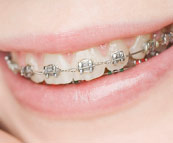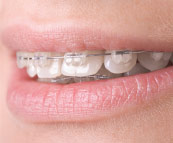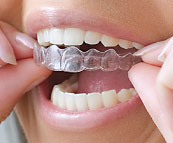The Magic of Orthodontics
The Original Smile Makeover
(Continued)
How and Why Do Teeth Move?
Orthodontic appliances, commonly known as “braces” describe the small brackets that are placed on teeth through which little flexible wires are threaded. These small wires place light forces on the teeth, as the wires tend to straighten themselves to their undistorted forms, moving the teeth with them. The reason the teeth move is due to the magical properties of the periodontal ligament (attaches the tooth to the bone). Since the periodontal ligament is elastic — teeth are not set in the bone like pillars in concrete — there is micro-movement of the teeth all the time. Since these tissues are living, they are constantly changing and “remodeling.” When a light and controlled force is placed on a tooth on the “tension” or pulling side, new bone, ligament and cementum are formed. On the pressure side, cells will remove bone and ligament to allow the tooth to move. It is analogous to a hot knife moving through a stick of butter; it melts on one side and coalesces on the opposite side as the knife moves through the butter.
A Stable End Result
Overall, goals of orthodontic treatment are esthetics, function, health, and stability, all of which must be taken into consideration. The diagnosis of tooth position discrepancies and bite issues, including why your teeth are “where they are,” is fundamental. It is equally imperative to determine where they should be, the method to moving your teeth and how stable the result will be once the treatment has been completed (stabilization and retention). That's another reason that an orthodontist or a dentist who has advanced training and experience in orthodontics is so critical to your treatment plan.
 |
| Figure 1: An example of metal braces used with light orthodontic wires during full-banded orthodontic treatment. |
 |
| Figure 2: An example of clear orthodontic braces with light orthodontic wires during full-banded orthodontic treatment. |
 |
| Figure 3: An example of clear orthodontic aligners used to move teeth in the most esthetic manner possible. |
Appliance Options
When considering orthodontic appliances, there are several options. The “gold standard” in orthodontic treatment has been the orthodontic band for posterior teeth and the bonded bracket for anterior teeth [Figure 1]. For people who wish to have the most esthetic appliances, “clear” brackets are an alternative option [Figure 2]. Clear brackets are less visible, but are more susceptible to breakage. Consequently, clear brackets must be cared for during treatment by avoiding excessively hard foods or extreme contact e.g., during sports. Both these types, traditional and clear brackets, are known as fixed appliances, because they can't be taken out by you, the patient.
Another approach to treatment involves the use of clear aligners to reposition teeth [Figure 3]. This is useful in situations which are generally milder in nature. After very careful assessment, a series of computer generated clear plastic trays are made to move the mal-aligned teeth. The clear aligners, each one a little different than the preceding one, progressively move the teeth into better alignment. This is the most modern choice of removable appliances.
With any orthodontic appliance, typically simple movements may take a matter of months, while complex movements may take months to two or three years.
Overall, the fixed appliances (brackets — metal or clear) are the ones of choice in more complex/comprehensive cases because they enable the orthodontist to accomplish desired three dimensional tooth movements, in the most efficient and predictable manner [Figures 4-7].
Removable appliances, clear aligners, are generally better for simpler or tipping movements of teeth, in “2D” (two dimensions) and which can be accomplished “invisibly” with little or no esthetic compromise. Consequently, in either situation treatment time is kept to the minimum necessary to realign the teeth. Either way diagnosis is the most important factor in choosing the right kind of appliances to do the job.

